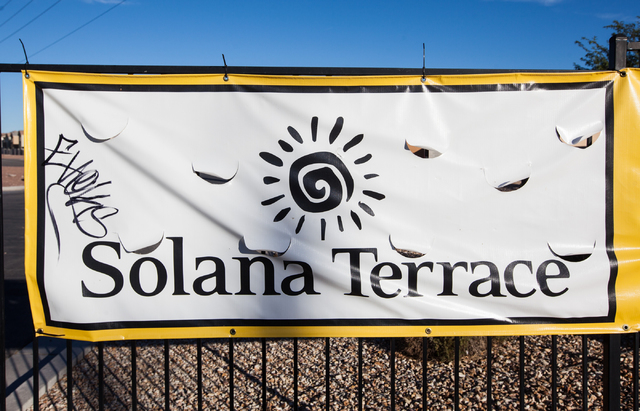Las Vegas builder stages comeback with affordable homes
A casualty of Southern Nevada’s housing bust is making a comeback.
And the company is reviving its operation by offering what executives and local analysts alike say will be the most affordable new single-family homes in the Las Vegas Valley, with prices starting below $150,000.
Signature Homes, a 40-year-old local builder that stopped building single-family homes in the downturn, is relaunching its single-family operation with Solana Terrace, a community of about 50 homes in the northeast near Las Vegas and Nellis boulevards. Signature is scheduled to deliver Solana Terrace’s first five homes at the end of November, and another five in December. Sales models will be open to visitors after Thanksgiving, said Richard Plaster, Signature’s founder and president.
It will be the first new single-family subdivision since the recession for what was once one of the local market’s biggest homegrown builders.
The 10 homes Signature will deliver through year’s end are a far cry from the 800-plus homes a year the company routinely delivered in the 1990s. Since its founding in 1978, Signature has built roughly 12,500 local single-family homes, condominiums and apartments, Plaster said.
But as small as it may be, Signature’s single-family rebirth will fill what observers say is a desperate need for attainable new homes.
Prices at Solana Terrace begin at around $145,000 for homes with up to five bedrooms and 1,715 square feet. Also standard are quartz kitchen countertops and appliances including washers, dryers, refrigerators and microwaves.
“We know there are people out there who need this,” Plaster said.
Dennis Smith of Home Builders Research said he doesn’t know of a less-expensive single-family product under construction in Las Vegas or Henderson.
Signature can build in its price range because it has held the land for more than a decade, Plaster said. The company bought the property before the big run-up in land prices during the housing bubble, so it can afford to keep prices at roughly half of the marketwide new-home median, which Smith pegged at $299,601 in September.
Beyond its land basis, other forces make Solana Terrace a solid development proposition, Smith said.
The number of affordable new homes has dwindled in the last year: Just 7.8 percent of the market was priced below $200,000 in September, down from 18.3 percent in September 2013. That means less competition for a big market segment.
Plus, mortgage interest rates have dropped. September’s monthly average of 4.16 percent for a 30-year, fixed-rate home loan was down from 4.49 percent a year earlier, according to numbers from federal loan backer Freddie Mac.
There are obstacles, too, Smith said: Buyers below $150,000 are likelier to be first-time home buyers with lower credit scores and small, if any, down payments.
“The hardest part will be getting people qualified (to borrow),” he said.
Plaster agreed that the demographic Signature is targeting includes consumers “of more modest incomes who have been hurt by the Great Recession.”
But Signature is starting small. If this 50-lot “test” of the market works, Signature has an additional 76 parcels to develop next door, Plaster said.
As far as tests go, it’s the easiest one Signature has faced in nearly a decade.
The company never truly went away. It has a property management arm through which it oversees about 1,000 local apartment units, many of them properties it developed.
Company officials stopped buying land for single-family development in 2003, though, as the price per acre soared from around $200,000 to $800,000. Signature’s work force shrank as building stopped, falling from 150 to 60 — layoffs that Plaster called “the toughest part” of the downturn.
Now, Plaster said he believes the market has hit bottom and is in a “new normal” that made it easier to justify developing at a lower price range in a part of town that hasn’t seen new development in years. Signature isn’t angling to get as heavily into the single-family home business as it once was, Plaster said, but the company will look for additional opportunities, including joint ventures, to serve a consumer segment that he said has been largely left behind in today’s market.
“If the national builders that dominate the market today are interested in being the high-end market because that’s where the profits are, then we know a lot of smaller lots that would be appropriate to build less-expensive houses,” Plaster said.
Contact Jennifer Robison at jrobison@reviewjournal.com. Follow @J_Robison1 on Twitter.





























